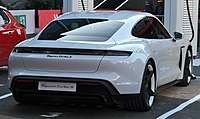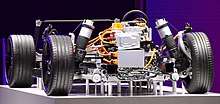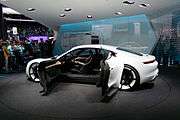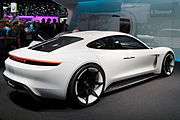Porsche Taycan
The Porsche Taycan is an all-electric car manufactured by German automobile manufacturer Porsche, which was first unveiled as a concept car named Mission E at the 2015 Frankfurt Motor Show[4] and then in production form at the 2019 Frankfurt Motor Show.[3] It is Porsche's first series production electric car,[4] and is planned to be sold in several variants of different performance levels, and it could spawn derivatives in a future line-up of models based on its platform.[5] Around 4,480 were delivered in the first half-year of sale, 2020.[6]
| Porsche Taycan | |
|---|---|
 | |
| Overview | |
| Manufacturer | Porsche |
| Also called | Porsche Mission E |
| Production | 2015 (concept) 2019–present |
| Assembly | Germany: Stuttgart |
| Designer | |
| Body and chassis | |
| Class | Executive car (E) |
| Body style |
|
| Layout | Dual-motor, all-wheel drive |
| Platform | J1 |
| Related | Porsche Panamera |
| Powertrain | |
| Engine | 2 AC synchronous electric motors, front and rear axle |
| Transmission |
|
| Battery | 79.2 or 93.4 kWh liquid-cooled lithium-ion |
| Electric range | 333 to 463 km (206.9 to 287.7 mi) (WLTP combined), 201 mi (323.5 km) (EPA) |
| Plug-in charging | |
| Dimensions | |
| Wheelbase | 2,900 mm (114.2 in) |
| Length | 4,963 mm (195.4 in)[3] |
| Width | 1,966 mm (77.4 in) |
| Height | 1,378–1,381 mm (54.3–54.4 in) |
| Kerb weight | 2,140–2,305 kg (4,717.9–5,081.7 lb) |
Nomenclature
The name "Taycan" roughly translates from Turkish as "lively young horse" in reference to the steed of the Stuttgart coat of arms on the Porsche crest.[7][8]
Design
The interior of the car is based around up to four digital displays, including a curved, free-standing 16.8 inch configurable driver's display. This marks Porsche's first fully digital instrument binnacle. A 10.9 inch screen is situated to the right of the instrument binnacle which serves as the infotainment system of the car. An optional screen is placed to the right of the infotainment screen which allows the front passenger to customise the infotainment system. An 8.4 inch screen is present in a portrait layout on the centre console with a trackpad to control the functions. The screen displays the status of the powertrain and tells the driver to efficiently use the power. Despite using an all-digital layout, the dashboard features the classic Porsche clock on the top.
The exterior styling, penned by former Porsche Exterior Designer Mitja Borkert, is strongly influenced by the Mission E concept and retains most of the design elements present on the concept except the suicide doors and B pillars. Design features include a retractable rear spoiler, retractable door handles and an advanced regenerative braking system. Taking full advantage of the packaging advantages inherent in its drivetrain layout, the Taycan combines the fundamental short-nosed proportions of traditional Porsche models at the front with the stretched proportions of modern front-engine models towards the rear, providing clear design links to existing models. The front features four-point LED daytime running headlamps. At the rear, the car has a short notchback-style boot lid housing a full-width light band serving as taillights and turn signals that provides access to one of two luggage compartments. The other is under the bonnet and claimed to have a capacity of nearly 100 litres. The launch Turbo and Turbo S models come in a carbon fibre trim and 20-inch wheels as standard.
 Rear view
Rear view.jpg) Interior
Interior
Specifications

The body of the Taycan consists mainly of steel and aluminium joined together by different bonding techniques. The B pillars of the body, side roof frame and seat cross member are made from hot-formed steel while the bulkhead cross member is made from boron steel to improve safety. The shock absorber mounts, axle mounts and rear side members are made from forged aluminum, while all body panels except the front and rear bumpers are also made from aluminum to reduce weight. In total, 37% of the car is constructed of aluminium.[9]
The Taycan uses a new battery-electric drivetrain consisting of a permanent-magnet synchronous motor on each axle, allowing the car to have an all-wheel drive layout. At the front, power is sent to the wheels through a single-speed gearbox (8.05:1 gear ratio). At the rear, power is sent to the rear wheels through a two-speed transmission and a limited slip differential. The gearbox has a short planetary first gear (15.5:1) providing maximum acceleration performance and a long-ratio second gear (8.05:1) delivering top speed and efficiency.[2] Power comes from a 93 kWh 630 kg (1,389 lb) lithium-ion battery pack that doubles as a structural chassis component and keeps the center of gravity low.[2] In order to address space issues for passenger sitting on the rear seats, recesses called "foot garages" have been incorporated in the battery pack to improve legroom. The 723 volt pack (835 volt full, 610 volt empty) has 33 modules with 12 LG Chem pouch cells each, for 396 cells in total.[2][10]
The driving range depends upon how the car is driven and what driving mode is selected. A "range" driving setting puts the car in a power save mode with the lowest power consumption. The car has a total of five modes namely Sport, Sport Plus, Normal, Range along with an Individual mode in which the driver can customise various settings of the car.[11] Regenerative braking provides up to 265 kW,[12] yielding a deceleration of 0.39 G.[2]
Porsche has developed an 800-volt charging system specifically for the Taycan. According to manufacturer estimates, the battery pack can be charged from a 5% state of charge to 80% in 22.5 minutes in ideal situations, with a DC fast charger offering 270 kW of power. Charge times are dependent on weather conditions and infrastructure. When purchasing a Taycan, owners receive three years free access to the speed charging infrastructure of Porsche's joint venture partner, IONITY.[13]
To reduce charge times in both hot and cold temperatures, the battery can be thermally preconditioned using a charging planner. Owners simply need to set a departure time in the planner and the car will automatically warm or cool the battery for optimal charging times. A charging dock and mobile charger supplied with the car for home charging connect with a 9.6-kW connector that charges the car in 11 hours. Porsche has also developed an energy manager that can be installed in the house's circuit breaker. It is capable of managing a house's power flow, providing cost optimising charging, using solar power and providing blackout protection by reducing the charge to the car if other household appliances, such as fridges or dryers, turn on and exceed the breaker's max power threshold.[14]
The Taycan Turbo has a drag coefficient of Cd=0.22, which the manufacturer claims is the lowest of any current Porsche model. The Turbo S model has a slightly higher drag coefficient of Cd=0.25.[15][14] The frontal area is 2.33 m², with a resulting drag area of 0.513 m² and 0.583 m² for the Turbo and Turbo S, respectively.[16][17][18]
Models
The Taycan is initially being offered as a saloon model but an estate model called the Taycan Cross Turismo is due to be launched. Other planned variants include a two-door coupe and convertible models which will be put into production based on market demand. Models introduced at launch include the high performance AWD Turbo and Turbo S.[11] A mid-range model called the Taycan 4S with two battery sizes was added to the lineup in October 2019.[19] A RWD base model was announced in July 2020 for China.[20]
| Model | Years | Power | Torque | Weight (DIN) | 0–60 mph (97 km/h) | 0–100 km/h (62 mph) | Top speed | WLTP Range | EPA Range |
|---|---|---|---|---|---|---|---|---|---|
| Taycan[20] | 2020– | 300 kW (408 PS; 402 hp) | 5.2 seconds | 5.4 seconds | 230 km/h (143mph) | TBA | TBA | ||
| Taycan (Performance Battery Plus)[20] | 2020– | 350 kW (476 PS; 469 hp) | 5.2 seconds | 5.4 seconds | 230 km/h (143mph) | TBA | TBA | ||
| Taycan 4S[21] | 2020– | 390 kW (530 PS; 523 hp) | 640 N⋅m (472 lb⋅ft) | 2,140 kg (4,718 lb) | 3.8 seconds | 4.0 seconds | 250 km/h (155 mph) | 333–407 km (207–253 mi) | TBA |
| Taycan 4S (Performance Battery Plus)[21] | 2020– | 420 kW (571 PS; 563 hp) | 650 N⋅m (479 lb⋅ft) | 2,220 kg (4,894 lb) | 3.8 seconds | 4.0 seconds | 250 km/h (155 mph) | 386–463 km (240–288 mi) | 203 mi (327 km) |
| Taycan Turbo[22][23] | 2020– | 500 kW (680 PS; 671 hp) | 850 N⋅m (627 lb⋅ft) | 2,305 kg (5,082 lb) | 3.0 seconds | 3.2 seconds | 260 km/h (162 mph) | 381–450 km (237–280 mi) | 201 mi (323 km) |
| Taycan Turbo S[22][23] | 2020– | 560 kW (761 PS; 751 hp) | 1,050 N⋅m (774 lb⋅ft) | 2,295 kg (5,060 lb) | 2.6 seconds | 2.8 seconds | 260 km/h (162 mph) | 388–412 km (241–256 mi) | 192 mi (309 km) |
Notes: The values reported above (horsepower, torque and the acceleration times from 0 to 100 km/h) are achieved using the Overboost Power with Launch Control mode; otherwise, the maximum horsepower value is 240 kW (326 PS; 322 hp) for the base model, 280 kW (381 PS; 375 hp) for the base with Performance Battery Plus, 320 kW (435 PS; 429 hp) for the 4S, 360 kW (489 PS; 483 hp) for the 4S Performance Battery Plus, and 460 kW (625 PS; 617 hp) for the Turbo and Turbo S models.[23]
Mission E
Specifications
The Mission E was the concept car unveiled at the 2015 Frankfurt Motor Show that was the predecessor to the Taycan. Mission E was powered by two PSM permanently excited synchronous electric motors: one at the front axle and one at the back. All four wheels are individually controlled by the Porsche Torque Vectoring system. The two electric motors were projected to be rated at more than 440 kW (598 PS; 590 hp)[24] and it had projected performance figures of 0–100 km/h in less than 3.5 seconds, 0–200 km/h in less than 12 seconds and a top speed over 250 km/h (155 mph). Porsche said they were aiming for the Mission E to achieve a range of over 500 km (311 mi).[25]
The car system voltage was 800 V DC.[26] The batteries can be charged by an inductive plate or with a conventional charger system. Porsche claimed that with the Porsche Turbo Charging system the battery would be able to be charged at up to 350 kW of power, to 80% in just 15 minutes.[25]
 Porsche Mission E at the IAA 2015
Porsche Mission E at the IAA 2015 The suicide doors of the Porsche Mission E concept in open position
The suicide doors of the Porsche Mission E concept in open position Interior
Interior Front wheel
Front wheel Rear view
Rear view
Mission E Cross Turismo
The Porsche Mission E Cross Turismo concept is a Mission E derivative that was first presented at the 2018 Geneva Motor Show and combines the fully electric Mission E J1-platform with a 5-door estate body similar to the Panamera Sport Turismo, raised suspension, off-road tyres and cladding to form a crossover utility vehicle. According to Porsche Chief designer Michael Mauer the concept "shows possibilities of the future lineup."[27] On 18 October 2018 the Supervisory Board of Porsche AG gave the green light for the series production of the Cross Turismo.[28]
- Mission E Cross Turismo concept
- Rear 3/4 view
.jpg) Rear view
Rear view
References
- "Mission E: Porsche design of the future". newsroom.porsche.com. Porsche.
- Tracy, David (6 September 2019). "An Extremely Detailed Look At The Porsche Taycan's Engineering Designed To Take On Tesla". Jalopnik. Archived from the original on 30 December 2019.
- Vanderwerp, Dave (4 September 2019). "2020 Porsche Taycan Electric Sports Sedan Is the First Real Threat to Tesla". Car and Driver. Retrieved 4 September 2019.
- "Tribute to tomorrow. Porsche Concept Study Mission E. - Dr. Ing. h.c. F. Porsche AG".
- "Porsche Mission E due with Level 4 autonomy and 15min fast-charging". autocar.co.uk. Retrieved 28 March 2018.
- Taycan, Porsche. "Porsche Taycan Sales Hit Almost 4,500 In First Half Of 2020". InsideEVs. Retrieved 2020-07-23.
- Valdes-Dapena, Peter. "Porsche's first electric car will be called the Taycan". CNNMoney. Retrieved 2018-06-11.
- "Mission E becomes Taycan". newsroom.porsche.com. Retrieved 2018-06-08.
- "The body: Intelligent mix of materials for maximum strength". Porsche Newsroom.
- "The battery: Sophisticated thermal management, 800-volt system voltage". Porsche Newsroom.
- Valdes-Dapena, Peter (4 September 2019). "Porsche's first electric car has almost no switches, knobs or gauges. Here's what it does have". CNN. Retrieved 5 September 2019.
- Dow, Jameson (26 December 2019). "See what's underneath and inside the Porsche Taycan". Electrek.
- "Porsche Charging options for on the road. - Porsche AG". Porsche AG - Dr. Ing. h.c. F. Porsche AG. Retrieved 8 December 2019.
- Wong, Jon (4 September 2019). "2020 Porsche Taycan arrives with up to 750 hp, $150,900 base price". Road Show. Retrieved 5 September 2019.
- "Electric Porsche Taycan will be crucial to UK range, says boss". autocar.co.uk. Retrieved 21 March 2019.
- "World premiere of the Porsche Taycan". newsroom.porsche.com. Porsche. Retrieved 10 September 2019.
- "Taycan Turbo Technical Data" (PDF). newsroom.porsche.com. Porsche. p. 4. Retrieved 11 September 2019.
- "Taycan Turbo S Technical Data" (PDF). newsroom.porsche.com. Porsche. p. 4. Retrieved 11 September 2019.
- Porter, Jon (14 October 2019). "Porsche prices its 'entry-level' Taycan EV at just over $100,000". The Verge. Retrieved 22 October 2019.
- Weintraub, Seth (2020-06-29). "Porsche Taycan RWD makes China debut w/489km of NEDC range, uncertain if coming to US market". Electrek. Retrieved 2020-07-06.
- "Porsche Taycan 4S revealed with two power levels and a cheaper starting price". CNET.
- "Porsche Taycan By The Numbers: Specs, Range, Performance & More". Insideevs.
- "Porsche Taycan Turbo - Porsche USA". Porsche HOME - Porsche USA. Retrieved 12 September 2019.
- "Tribute to tomorrow. Porsche Concept Study Mission E. - Dr. Ing. h.c. F. Porsche AG". Technology.
- Lambert, Fred (2016-12-26). "10 electric cars coming in the next 3 years : 4 – Audi Q6 e-tron quattro SUV". Electrek. Retrieved 2017-03-17.
- Lambert, Fred (2019-07-29). "Porsche has 30,000 Taycan electric car reservations". Electrek.
- "Porsche reveals its Mission E Cross Turismo concept". topgear.com. Retrieved 28 March 2018.
- "Concept study Mission E Cross Turismo goes into series production - 300 new jobs". newsroom.porsche.com. Retrieved 2019-03-07.